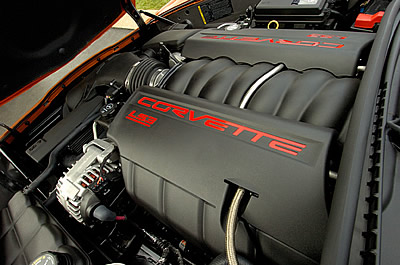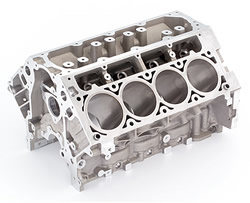Ruthless Pursuit of Power: Our In-Depth Look at the 2008 Corvette LS3 Engine - Page 1 of 6
Ruthless Pursuit of Power: 2008 Edition - Page 1 of 6
Our In-Depth Look at the New 2008 Corvette LS3 Engine
 © 2007 by Hib Halverson
© 2007 by Hib Halverson
No use without permission, All Rights Reserved
I turned left on I-65-north on-ramp, then buried the gas.
First: exhilaration
In seconds, I was near the top of third gear, watching traffic fly backwards when I lifted. This twenty-oh-eight, six-speed–new LS3 under the hood and optional "NPP" exhaust out back–was a freakin' rocket ship.
Then: despair.
I realized that now, my '04 Z06, good old "3Balls39", can't even keep up with a base C6. The new engine–6.2-liters, 436hp@5900 rpm–makes the standard Corvette about half-a-tenth quicker than the most aggressive Vette of just 48 months ago.
"This sucks!" I blurted.
The GM guy with me almost got a word out.
"Dude!" I cut him off. "The motor's awesome! What sucks is that it took you guys only four years to make a base car quicker than my 110-lbs. lighter C5Z."
At 75 in sixth, the '08 cruised effortlessly, demonstrating once again that wide "bandwidth" (cutting-edge performance combined with darn nice road manners) which has been a hallmark of America's Sports Car and the envy of some of the world's other great car makers since the ZR-1 years of the early-90s.
 As we rolled towards Bowling Green and the National Corvette Museum, I reflected
upon the LS3. General Motors' Generation-Three and -Four Small-Block V8s are
some of the World's great engines. Don't believe it? Just ask Mercedes-Benz.
When it owned Chrysler, it copied–oops–it benchmarked GM's Gen 3 Small-Block
architecture then reproduced key aspects of it in its current Hemi V8.
As we rolled towards Bowling Green and the National Corvette Museum, I reflected
upon the LS3. General Motors' Generation-Three and -Four Small-Block V8s are
some of the World's great engines. Don't believe it? Just ask Mercedes-Benz.
When it owned Chrysler, it copied–oops–it benchmarked GM's Gen 3 Small-Block
architecture then reproduced key aspects of it in its current Hemi V8.
Short Block Details
World-class engines have robust blocks, or "cylinder cases," as powertrain engineers say. The '08 Vette's 378-cubic inch, LS3 uses the same block as the L92, a high-performance Vortec 6200 truck engine. But–don't start flaming us about SUV motors. The L92 is light, compact, reliable, durable and powerful–just the foundation a Corvette engine needs.
The LS3 case shares basics most aluminum Gen 3s and 4s have had since that engine family debuted in the 1997 Corvette: deep skirted, 319-T5 aluminum block with siamesed, cast-in-place, gray iron liners which are centrifugally-cast to increase density and allow thinner walls, long head bolts threading deep into its main bearing webs and six-bolt, steel main bearing caps. All this makes a lightweight, rigid, block structure offering good durability and reduced friction.
Chrysler borrowing from that block design for V8s in its own full-sized trucks and performance cars says much about GM's engine technology. Some might be disbelieving of the Gen 3/4 block being so inspiring to a competitor but, if you ever see the two short blocks disassembled, side-by-side on a bench; the influence will be obvious. Imitation is the best form of flattery.
There are improvements in the LS3 block. Compared to last year's six-liter, the liners have .084-in larger bores, its main bearing webs are about 20% stronger and their "windows", which enhance "bay-to-bay breathing" in the interest of oil control and reduced parasitic loss, have been somewhat enlarged.
